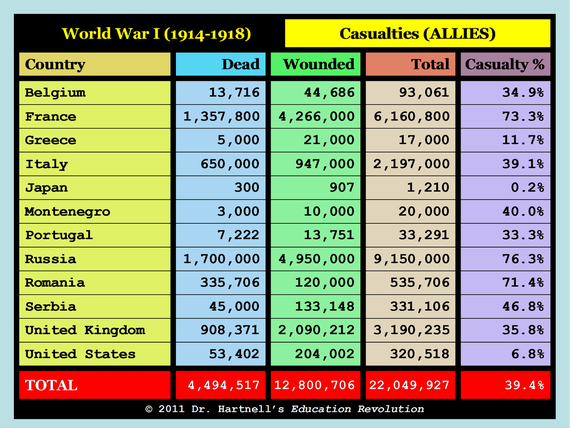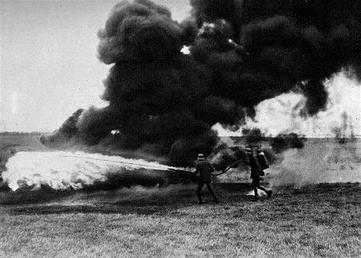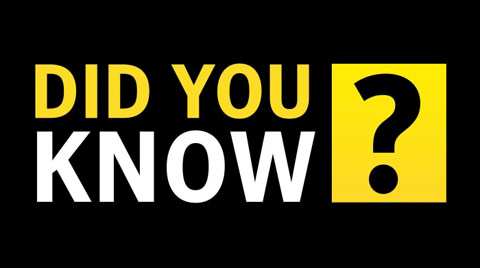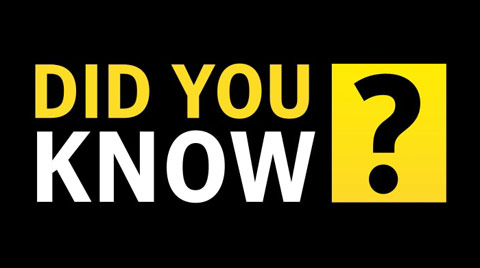Scramblin' thru... World War I
The War to End All Wars...
World War I was a military conflict that lasted from August 4, 1914 until November 11, 1918 and involved many of the countries of Europe, the U.S., and other nations around the world.
World War I was one of the most violent and destructive wars in history. Of the 65 million men who were mobilized, more than 10 million were killed and more than 20 million wounded. World War I was the first total war. The countries involved mobilized their entire populations and economic resources to achieve victory on the battlefield. The term "home front" was widely used for the first time during World War I and perfectly symbolized a war in which civilians behind the lines were directly involved in the war effort. The war began as a clash between two coalitions of European countries. The first coalition, known as the Triple Entente (later the Allied Powers), included Britain, France, Belgium, Serbia, Montenegro, and Russia. The other, the Central Powers, consisted of the empires of Germany and Austria-Hungary. Soon, Japan (Allies), the Ottoman Empire (Central Powers), Italy (Allies), and Bulgaria (Central Powers) joined in the fight. Although the U.S. initially remained neutral, it joined the Allies in 1917. The conflict eventually involved 32 countries, 28 of which supported the Allies. The causes of the conflict were rooted deeply in the European history of the previous century, particularly after 1871, the year that Germany was unified and emerged as a major power. Nationalism, imperialism, militarism, and alliance systems all played a major role as well. What ignited this powder keg, however, was the assassination of Archduke Franz Ferdinand, the heir to the throne of Austria-Hungary. Ferdinand and his wife were in Bosnia visiting the small country that had been annexed by Austria-Hungary six years earlier when both were shot and killed by 19-year-old Gavrilo Princip. Princip, a member of the extremist group Black Hands, was a Serbian nationalist that wanted to unite all Serbs (including those in Bosnia) into a single country. (Princip was sentenced to 20 years in prison... where he died of tuberculosis.) The assassination set off a diplomatic crisis. Austria-Hungary saw the assassination as a chance to crush Serbia once and for all and end the possibility of future Serbian uprisings. As such, Austria-Hungary quickly declared what it expected to be a "bright, brisk little war" against Serbia. However, one thing got in the way... the alliance system. Like a series of dominos, several countries were pulled into the war when their ally entered the conflict. Because it was the protector of the Slavic people (which included Serbs), Russia began to mobilize its troops in defense of Serbia. Austria-Hungary was no match for Russia by itself, so Germany declared war on Russia on August 1st. Two days later, Germany also declared war on Russia's ally France. Bound by mutual defense treaties, Britain declared war on Germany on August 4th as German troops invaded Belgium on their way to attack France. On August 5th, the U.S. declared its neutrality and offered to mediate the growing conflict (lame!). Knowing it had Germany on its side, Austria-Hungary declared war on Russiaon on August 6th, and... BAM... in a matter of days, Europe was sucked into a massive conflict. The Great War had begun. By the end of 1914, the war was stalemated. Both sides became literally stuck in two main, stationary fronts – the Western Front (primarily in Northeastern France) and the Eastern Front (mainly in Western Russia). At the fronts, the troops fought each other from trenches. [Please click here to view additional information on events of the war.] When the war finally came to an end on November 11, 1918, and the Central Powers were defeated, the political order of Europe had been transformed beyond recognition. The German, Austro-Hungarian, Russian, and Ottoman Empires had collapsed. New countries were carved out of their former lands, and the boundaries of many other countries were redrawn. The war also saw Russia's Bolshevik Revolution transform the nation into the powerhouse Communist Soviet Union. The military boost the Allied Powers received by the entrance of the U.S. in 1917 firmly established the American military as a force to be reckoned with – and reserved the U.S. a seat at the grown-up table of world affairs. The war also had important long-term consequences. The enormous cost of the war undermined the financial stability of all of the countries involved, and they had to bear a burden of debt for many years to come. These financial losses, combined with the battlefield deaths and physical destruction, severely weakened the European powers. The harsh terms of the Treaty of Versailles have been cited by historians as a direct cause of World War II (1939-1945). |
The term "World War I" was not used until a second worldwide conflict broke out in 1939 (World War II). Before that year, the war was simply known as
"The Great War", "The War to End All Wars", "The War to Make the World Safe for Democracy", or just "The World War". World War I saw major advances in weaponry. At the start of the war, the main infantry weapon was the bolt-action magazine rifle, which was capable of firing 6-10 aimed shots per minute. The machine gun (which had been developed in the 1880s and was the offspring of the Gatling gun) was quickly adopted because it could fire rifle ammunition automatically at a rate of 200-250 shots per minute. Other important weapons were the flamethrower, the hand grenade, poisonous gas, the tank, and submarines called Unterseeboots ("undersea boats" or simply U-boats).
On November 11, 1918, at 5:00am, the Allied and German delegates signed an armisticeon; at 11:00 the same morning, hostilities along the Western Front officially came to an end. The end of the war on the "11th hour of the 11th day of the 11th month of 1918" was selected so every person would remember the exact moment when the last war was ever fought.
Obviously, this was not the case. Still, the next year, President Woodrow Wilson proclaimed November 11th as "Armistice Day". A Congressional Act in 1938 made the 11th of November of every year "Armistice Day". Congress amended its own act in 1954 and renamed the holiday "Veterans Day", which is observed every year. Germany signed the Treaty of Versailles on June 28, 1919. The treaty forced them to return the disputed territory of Alsace and Lorraine to France.
They had to demilitarize themselves (meaning no air force, a reduced navy, and no more than 100,000 soldiers in their army). They had to accept an Allied occupation of the Rhineland and give up their colonies. They were to take credit for starting the war (which they didn't) and pay $33 billion in reparations to the Allies, which was never collected because they were $100 billion in debt. The Treaty of Versailles ended WWI, however, the U.S. never ratified it!
Because the Republican-controlled Senate was left out of the peace talks by President Wilson (a Democrat), it refused to ratify the treaty. Determined, Wilson began a cross-country tour to gain popular support of the treaty and the League of Nations. Unfortunately, on September 25th, he suffered a stroke. Wilson recovered by November, but the Senate still refused to ratify the treaty. As a result, the U.S. signed a separate peace treaty with Germany (the Treaty of Berlin) in 1921. As for the League of Nations... even though all of the signatories in Paris accepted it, because the Treaty of Versailles went down in flames, the U.S. never joined. Without U.S. participation, the League was doomed. |
Country-by-Country Casualty Breakdown

This chart shows the casualties for the countries that fought for the Allies during WWI. The category of "Dead" includes both KIA and Other Deaths. The category of "Total" adds up all possible casualties, included MIA, which is why the number is not simply "Dead" and "Wounded" added together. The category of "Casualty %" refers to the percentage of casualties sustained by the troops that were mobilized. For example, Russia mobilized 12,000,000 troops and suffered 9,150,000 total casualties. This works out to 76.3%. [Click the chart for a larger version.]

This chart shows the casualties for the countries that fought for the Central Powers during WWI. The category of "Dead" includes both KIA and Other Deaths. The category of "Total" adds up all possible casualties, included MIA, which is why the number is not simply "Dead" and "Wounded" added together. The category of "Casualty %" refers to the percentage of casualties sustained by the troops that were mobilized. For example, Austria-Hungary mobilized 7,800,000 troops and suffered 7,020,000 total casualties. This works out to 90.0%. [Click the chart for a larger version.]
U.S. Casualty Report from World War I

Duration: 1917-1918 (19 months)*
U.S. Soldiers Involved: 4,734,991
U.S. KIA: 53,402
U.S. Other Deaths: 63,114
U.S. Wounded: 204,002
U.S. Total Casualties: 320,518
U.S. Casualty Percentage: 6.77%
U.S. Casualties per Month: 16,869
* World War I began in 1914, but the U.S. was not involved until 1917.
U.S. Soldiers Involved: 4,734,991
U.S. KIA: 53,402
U.S. Other Deaths: 63,114
U.S. Wounded: 204,002
U.S. Total Casualties: 320,518
U.S. Casualty Percentage: 6.77%
U.S. Casualties per Month: 16,869
* World War I began in 1914, but the U.S. was not involved until 1917.























